The Royal Monastery of Santa Maria de Poblet is a Cistercian Monastery. The monastery is located in Catalonia, an autonomous community in the northeast of Spain. The monastery is located west of Barcelona, the capital city of Catalonia. The monastery is surrounded by a large forested landscape. The Poblet Monastery was built between the 12th and 18th centuries. The monastery consists of three walled enclosures, the innermost of these enclosures forms the monastery itself and is surrounded by a 14th century wall. Access to the monastery is through the Royal Gate, the Porta Reial. In the 13th century chapter house the ribs of the vault are in the shape of a huge palm tree. In the paving are the tombstones of many abbots. In the monastery church, placed on two arches, are the royal tombs. The Poblet Monastery church houses also a 16th century retable, the altarpiece was sculpted in alabaster and is the earliest Renaissance work in this area. The evolution of the Romanesque style into Gothic style can be seen in the Poblet Monastery, the Cistercian monastery is situated between Tarragona and Lleida, it stands on fertile land rich of water and protected by the Prades Mountains. Nowadays, the monastery is still functioning. The Poblet Monastery was declared a UNESCO World Heritage in 1991.
www.werelderfgoedfotos.nl © Copyright World Heritage Photos
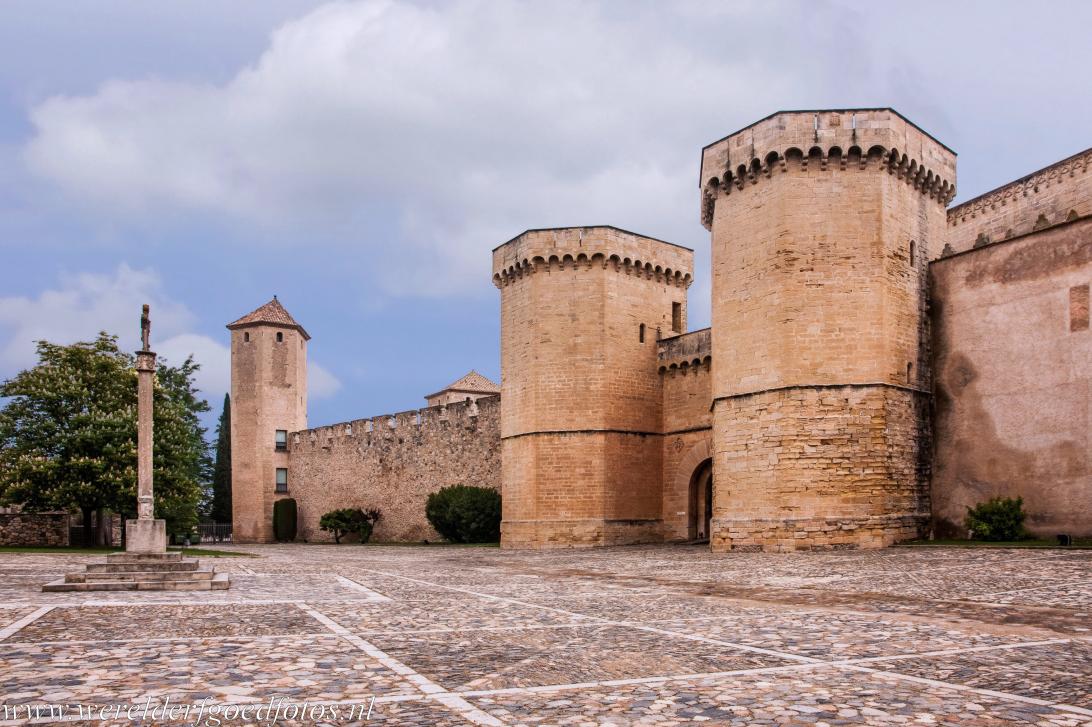
Access to the Poblet Monastery is through the Porta Reial, the Royal Gate, the gate is flanked by two huge towers. The Royal Gate was built in the 14th century. The monastery consists of three walled enclosures, the innermost of these enclosures forms the monastery, it is surrounded by a 14th century defensive wall. The Poblet Monastery is a UNESCO World Heritage.

Access to the Poblet Monastery is through the Porta Reial, the Royal Gate, the gate is flanked by two huge towers. The Royal Gate was built in the 14th century. The monastery consists of three walled enclosures, the innermost of these enclosures forms the monastery, it is surrounded by a 14th century defensive wall. The Poblet Monastery is a UNESCO World Heritage.
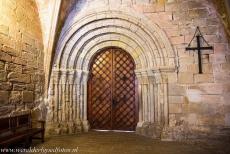
Poblet Monastery: The original Romanesque door into the Poblet Monastery dates back to the 12th century, the door is located behind the Royal Gate and provides access to the inner part of the monastery, this is oldest part of the monastery. Poblet Monastery was founded in 1151, the construction continued from the 12th to the 18th century.
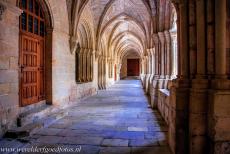
Poblet Monastery: The arched gallery of the cloister dates from the 12th and 14th centuries. The earliest parts of the Poblet Monastery are the south cloister and the lavabo, surrounded by the buildings of the monastery, such as the refectory, kitchen, chapter house, library, dormitory, the old scriptorium and the calefactorium, the only heated room in the monastery.
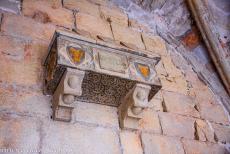
Poblet Monastery: In the arched gallery of the cloister are many family tombs of noble people who financially supported the monastery. The monastery was one of the largest monasteries in Spain, the Poblet Monastery reached the height of its power and splendour in 15th century. Now, it houses several museums, such as the Palace of King Martin and Restoration Museum.
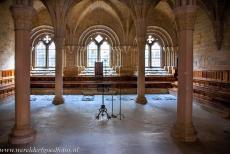
Poblet Monastery: In the 13th century Chapter house the ribs of the vaulted ceiling are shaped in the form of a palm tree. Many abbots of the monastery were buried under the floor of the Chapter house. The tomb slabs are a part of the floor paving of the Chapter house. The Chapter house was built in a harmonic combination of the Late Romanesque and the Early Gothic styles.
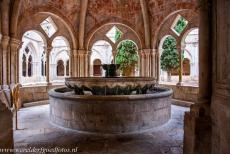
Poblet Monastery: The lavabo and fountain was used by the monks for cleaning and washings. The lavabo and the lavabo pavillion were built in the 12th century. The Poblet Monastery was built on fertile land rich of water, protected by the Prades Mountains. Now, about thirty monks still live and work in the Poblet Monastery. It is the largest inhabited monastery in Europe.
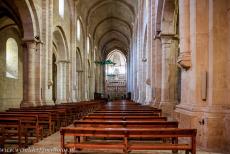
Poblet Monastery: The church was built in the 12th and 13th centuries, the north and central nave of the church were built in the Romanesque, the south nave in Gothic style. The church of the Poblet Monastery houses a 16th century retable, the earliest Renaissance work in the area. The altarpiece was sculpted in alabaster, carvings in alabaster were amongst the most prised.
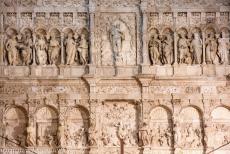
Poblet Monastery: A detail of the 16th century Renaissance retable. The retable was sculpted by Damià Forment. The retable was made of alabaster from Sarral, the small town was famous for its alabaster. The alabaster quarries in Sarral date back to Roman times. The largest niche of the retable houses a statue of Santa Maria de Poblet, Saint Mary of Poblet.
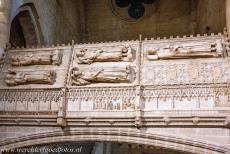
Poblet Monastery: A detail of one of the royal tombs, the tombs are situated in the transept of the monastery church. Some of the most important royal tombs are decorated with elaborate alabaster sculptures. The sculptures of the kings have a sculpted lion at their feet, the queens a sculpted dog. Eight Kings and Queens of Aragon and Catalonia were interred the church.
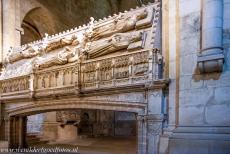
Poblet Monastery: In the monastery church, placed on two arches, are the royal tombs. Several Kings and Queens of Aragon and Catalonia were buried in the Poblet Monastery. The church of the monastery also houses the tombs of several princes. The church served as the Royal Aragon Mausoleum until the final years of the House of Aragon.
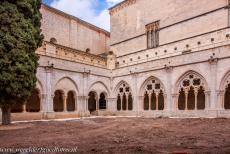
The evolution of the Romanesque style into the Gothic style is clearly visible in the cloisters of the Poblet Monastery. The small cloister of Saint Stephen was rebuilt in the 15th century. The Poblet Monastery is one of the three sister monasteries, known as the Cistercian triangle, the others two are the Monastery of Vallbona and the Monastery of Santes Creus.
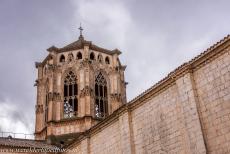
Poblet Monastery: The octagonal tower of the monastery church was built in the Gothic style. After the monastery was damaged in the 19th century, it was restored in the 20th century. The Poblet Monastery was declared a National Hispanic Heritage in 1921 and became a symbol of the restoration of a heritage. The Poblet Monastery became a UNESCO World Heritage in 1991.
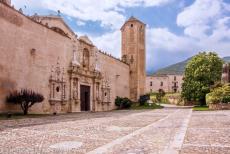
The Poblet Monastery is situated about 122 km west of Barcelona, it stands on fertile land rich of water and protected by mountains.The Cistercian monastery is situated in the autonomous community of Catalonia and is one of the largest monasteries in Spain. It was built between the 12th and 18th centuries. The Poblet Monastery became a UNESCO World Heritage in 1991.
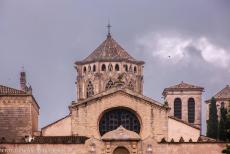
Poblet Monastery: The octagonal tower of the monastery church. The monastery was plundered during the First Carlist War, a civil war in Spain from 1833 to 1839. The monastery was closed in 1835. the buildings were plundered and partly destroyed by several fires. The restoration of the Poblet Monastery started in 1930, the monks returned in 1940.
